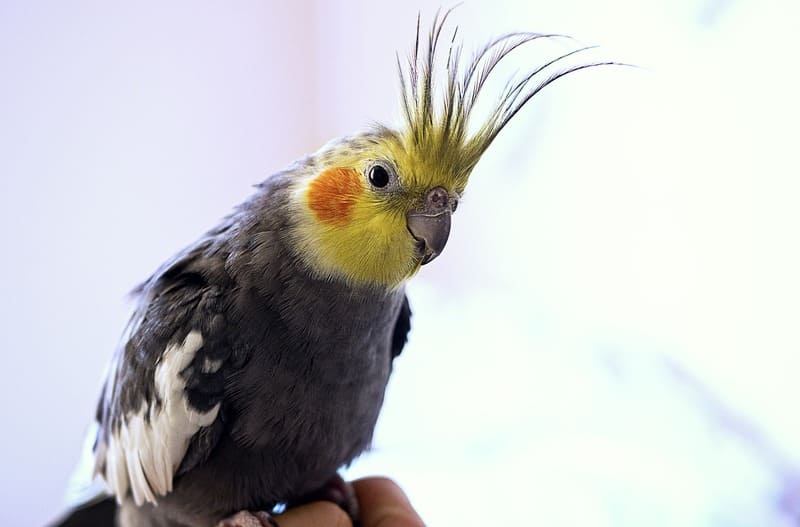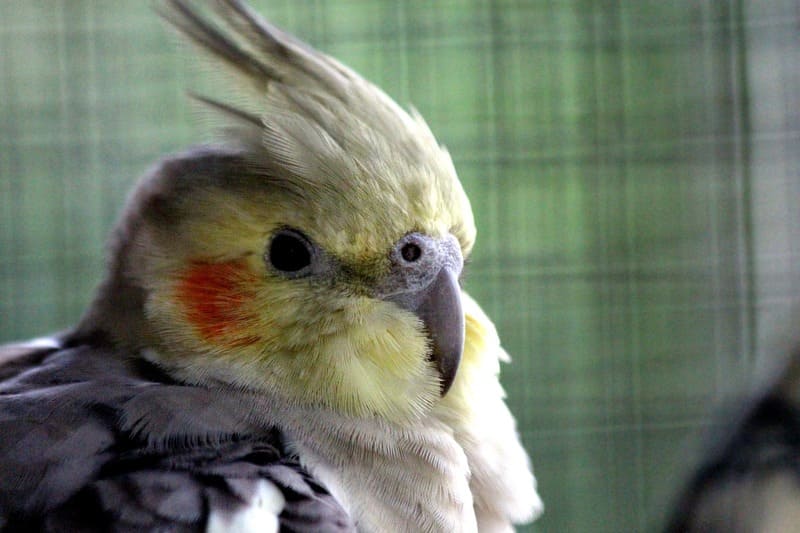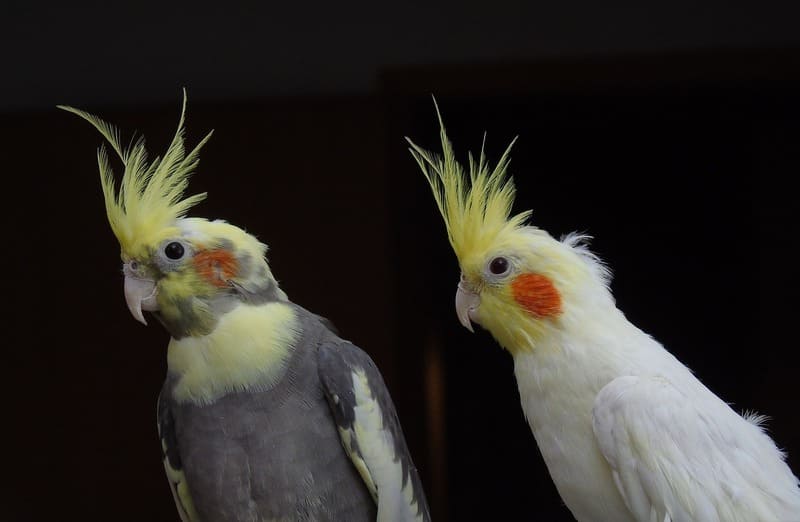Many pet owners are drawn to the idea of their various animals coexisting peacefully, like something out of a heartwarming Disney movie. The thought of a harmonious bond between a bird and a cat is undoubtedly appealing. However, when it comes to mixing species, especially those with significant differences in size and instincts, such as cats and birds, caution and consideration are paramount. In this extensive exploration, we will delve into the dynamics of cockatiels and cats, shedding light on the potential for friendship, safety concerns, and measures to ensure the well-being of both your feathered and feline friends.

The Nature of Cockatiels
Cockatiels (Nymphicus hollandicus) are small parrots native to Australia, renowned for their affectionate and sociable personalities. They have become popular pets around the world, cherished for their charming crests, engaging personalities, and the ability to form deep bonds with their human caregivers.
Here are some key characteristics of cockatiels:
- Social Birds: Cockatiels are naturally social creatures and thrive on interaction with their own kind as well as with humans. They enjoy being part of a flock, which is often mirrored in their attachment to their human families.
- Intelligence: These parrots are surprisingly intelligent and curious. They have a knack for learning tricks and mimicking sounds, including human speech.
- Vocal Abilities: While not as talkative as some parrot species, cockatiels are known for their gentle and melodious vocalizations. They can whistle tunes and even learn short phrases.
- Affectionate: Cockatiels have a reputation for being affectionate and enjoy physical contact with their owners. They may snuggle, preen, and seek head scratches.
- Playful Nature: Their playful behavior includes exploring their environment, playing with toys, and engaging in interactive games with their human companions.
- Longevity: When well cared for, cockatiels can have a relatively long lifespan, often exceeding 15 years or more.
The Predatory Instinct of Cats
Cats, whether domesticated or feral, are natural hunters. This predatory instinct is deeply ingrained in their biology and behavior. Cats have a heightened sense of sight, smell, and hearing, making them efficient hunters. While they may no longer need to hunt for survival when living with humans, the hunting instinct remains an essential part of their nature.
Key characteristics of a cat’s predatory behavior include:
- Stalking: Cats are stealthy stalkers. They use their keen senses to quietly approach their prey, whether it’s a bird, rodent, or insect.
- Pouncing: The pounce is a crucial element of a cat’s hunting technique. They use their powerful back legs to leap onto their prey.
- Playing: A cat’s play behavior often mimics hunting. They bat at toys, stalk moving objects, and engage in mock attacks.
- Biting and Killing: Cats are known for their sharp teeth and claws, which they use to catch, bite, and kill their prey.
- Bringing ‘Gifts’: Some cats may exhibit their hunting prowess by bringing home “gifts” in the form of dead or injured animals.
The Compatibility of Cockatiels and Cats
The potential for a harmonious relationship between a cockatiel and a cat is complex and largely dependent on the individuals involved, their socialization, and the precautions taken by the pet owner. Let’s explore the different aspects of their compatibility:
1. Individual Variability
The personalities and temperaments of both cockatiels and cats vary widely. Some cockatiels may be naturally confident and outgoing, while others may be more timid or easily stressed. Similarly, some cats may have a strong prey drive and be highly motivated to chase or catch smaller animals, while others may be less interested in hunting behavior.
The compatibility between a cockatiel and a cat can be influenced by the following factors:
- Early Exposure: If a cat is introduced to a cockatiel at a young age, they may be more likely to accept the bird’s presence and view it as a member of the household rather than prey.
- Previous Experiences: Cats that have been exposed to birds in the past, either through outdoor interactions or through living with other bird species, may exhibit different behaviors when introduced to a cockatiel.
- Socialization: Well-socialized cats are more likely to have positive interactions with other animals. Cats that are accustomed to being around dogs or other cats may be more adaptable to cohabiting with a cockatiel.
- Prey Drive: The intensity of a cat’s prey drive can vary significantly. Some cats have a strong instinct to chase and catch smaller animals, while others may be less motivated by hunting behavior.
2. Supervision and Safety
Regardless of their individual personalities and experiences, it’s essential to prioritize safety when introducing a cockatiel and a cat. Safety measures include:
- Supervision: Whenever the cockatiel and the cat are in the same space, they should be under close and constant supervision. This ensures that any potential interactions can be monitored, and interventions can occur if necessary.
- Separation: It may be advisable to keep the cockatiel and the cat in separate areas of the home when unsupervised. This can prevent any unwanted or potentially dangerous encounters.
- Secure Enclosures: If you have a dedicated bird room or area for your cockatiel, ensure that it is escape-proof and cat-proof. Cats should not have access to this space.
- Cage Security: If your cockatiel is in a cage, make sure that the cage is secure and cat-proof. Cats should not be able to reach or disturb the bird while it is in its cage.
3. Behavioral Training
Both cats and cockatiels can benefit from behavioral training to promote positive interactions and reduce potential conflicts.
- Cat Training: If you have a cat with a strong prey drive, training can help redirect their focus and teach them to ignore the cockatiel. Positive reinforcement training can be effective in teaching cats to associate the presence of the bird with rewards rather than hunting opportunities.
- Cockatiel Training: Cockatiels can also be trained to be more confident and calm around the cat. Training can help them understand cues of safety and be less prone to stress when the cat is nearby.
4. Separate Spaces
Creating separate living spaces for your cat and cockatiel is a practical solution that minimizes the risk of encounters. In many cases, it’s best to keep the two animals in entirely separate rooms with doors or barriers that prevent access.
- Bird Room: Designate a specific room or area as a bird room where your cockatiel can spend most of its time. This room should be off-limits to the cat.
- Cat-Free Zones: Ensure that your cockatiel has areas where it can move freely without the presence of the cat. This can be achieved through the use of pet gates, room dividers, or closed doors.
5. Positive Associations
Fostering positive associations between your cat and cockatiel can contribute to a more harmonious coexistence.
- Treats and Rewards: Reward your cat for calm and non-aggressive behavior around the cockatiel. Similarly, offer treats and rewards to the cockatiel when it sees the cat without reacting fearfully.
- Visual Contact: Gradual exposure to visual contact without direct physical access can help both animals become accustomed to each other’s presence.
6. Bird Safety
In addition to cat safety, it’s essential to consider the safety of the cockatiel. This includes providing an escape route and a secure environment. Cockatiels can become stressed if they constantly feel threatened by a nearby cat, so it’s important to ensure that they have a safe space.
7. Time and Patience
Introducing a cat and a cockatiel should be a slow and gradual process. Rushing the introduction can lead to stress and potentially dangerous situations. Be patient and give both animals time to adjust to each other’s presence.

When Friendship Is Possible
While the primary focus should be on safety and cautious coexistence, it is possible for a cockatiel and a cat to develop a friendly and peaceful relationship. This usually occurs when:
- The cat has a low prey drive and a mild curiosity about the cockatiel.
- The cockatiel is confident and unafraid of the cat.
- Both animals have been properly introduced and have spent time in each other’s presence without negative incidents.
In such cases, the two animals may tolerate each other’s company and even engage in playful interactions. However, it’s essential to remember that even in seemingly friendly relationships, instinctual behavior can surface unexpectedly, so vigilance should always be maintained.
Signs of Stress and Discomfort
Monitoring the well-being of both the cockatiel and the cat is crucial. It’s essential to recognize signs of stress or discomfort in both animals. These signs can include:
Signs of Stress in Cockatiels:
- Puffed-up feathers
- Frequent vocalizations or screaming
- Increased heart rate
- Panting or rapid breathing
- Attempting to fly away or escape
- Aggressive or defensive behavior
Signs of Stress in Cats:
- Dilated pupils
- Hissing or growling
- Stalking or intense focus on the bird
- Pacing or restlessness
- Excessive grooming, especially around the mouth (a sign of excitement or agitation)
If you observe signs of stress or discomfort in either the cockatiel or the cat, it’s crucial to separate them and reassess the situation. Intervening early can prevent negative interactions and long-term stress.

Final Considerations
The potential for a friendship between a cockatiel and a cat is subject to numerous variables, including the individuals’ personalities, their past experiences, and the precautions taken by the pet owner. While some cockatiels and cats may coexist peacefully, it’s essential to prioritize safety, supervision, and the well-being of both animals.
In some cases, it may be more practical to keep the two species entirely separate, allowing each to thrive in their own environment without the stress or risk of cohabitation. Ultimately, the welfare of your cockatiel and cat should be the foremost concern, and their happiness can be achieved through various forms of interaction, enrichment, and companionship that don’t necessitate close physical proximity.
If you are determined to introduce a cockatiel and a cat into the same household, consult with experienced pet owners, veterinarians, or animal behaviorists for guidance on making the process as safe and smooth as possible. Every situation is unique, and the well-being of your pets should guide your decisions.
